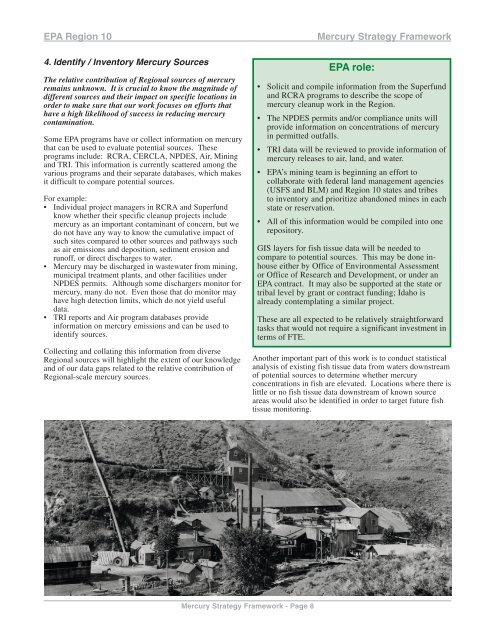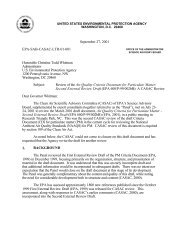EPA Region 10 Mercury Strategy Framework - Environmental ...
EPA Region 10 Mercury Strategy Framework - Environmental ...
EPA Region 10 Mercury Strategy Framework - Environmental ...
- No tags were found...
Create successful ePaper yourself
Turn your PDF publications into a flip-book with our unique Google optimized e-Paper software.
<strong>EPA</strong> <strong>Region</strong> <strong>10</strong>4. Identify / Inventory <strong>Mercury</strong> SourcesThe relative contribution of <strong>Region</strong>al sources of mercuryremains unknown. It is crucial to know the magnitude ofdifferent sources and their impact on specific locations inorder to make sure that our work focuses on efforts thathave a high likelihood of success in reducing mercurycontamination.Some <strong>EPA</strong> programs have or collect information on mercurythat can be used to evaluate potential sources. Theseprograms include: RCRA, CERCLA, NPDES, Air, Miningand TRI. This information is currently scattered among thevarious programs and their separate databases, which makesit difficult to compare potential sources.For example:• Individual project managers in RCRA and Superfundknow whether their specific cleanup projects includemercury as an important contaminant of concern, but wedo not have any way to know the cumulative impact ofsuch sites compared to other sources and pathways suchas air emissions and deposition, sediment erosion andrunoff, or direct discharges to water.• <strong>Mercury</strong> may be discharged in wastewater from mining,municipal treatment plants, and other facilities underNPDES permits. Although some dischargers monitor formercury, many do not. Even those that do monitor mayhave high detection limits, which do not yield usefuldata.• TRI reports and Air program databases provideinformation on mercury emissions and can be used toidentify sources.Collecting and collating this information from diverse<strong>Region</strong>al sources will highlight the extent of our knowledgeand of our data gaps related to the relative contribution of<strong>Region</strong>al-scale mercury sources.<strong>Mercury</strong> <strong>Strategy</strong> <strong>Framework</strong><strong>EPA</strong> role:• Solicit and compile information from the Superfundand RCRA programs to describe the scope ofmercury cleanup work in the <strong>Region</strong>.• The NPDES permits and/or compliance units willprovide information on concentrations of mercuryin permitted outfalls.• TRI data will be reviewed to provide information ofmercury releases to air, land, and water.• <strong>EPA</strong>’s mining team is beginning an effort tocollaborate with federal land management agencies(USFS and BLM) and <strong>Region</strong> <strong>10</strong> states and tribesto inventory and prioritize abandoned mines in eachstate or reservation.• All of this information would be compiled into onerepository.GIS layers for fish tissue data will be needed tocompare to potential sources. This may be done inhouseeither by Office of <strong>Environmental</strong> Assessmentor Office of Research and Development, or under an<strong>EPA</strong> contract. It may also be supported at the state ortribal level by grant or contract funding; Idaho isalready contemplating a similar project.These are all expected to be relatively straightforwardtasks that would not require a significant investment interms of FTE.Another important part of this work is to conduct statisticalanalysis of existing fish tissue data from waters downstreamof potential sources to determine whether mercuryconcentrations in fish are elevated. Locations where there islittle or no fish tissue data downstream of known sourceareas would also be identified in order to target future fishtissue monitoring.<strong>Mercury</strong> <strong>Strategy</strong> <strong>Framework</strong> - Page 8
















